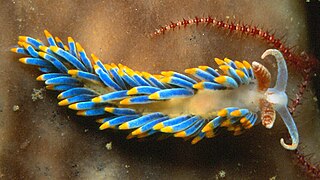
Nudibranchs belong to the order Nudibranchia, a group of soft-bodied marine gastropod molluscs that shed their shells after their larval stage. They are noted for their often extraordinary colours and striking forms, and they have been given colourful nicknames to match, such as "clown", "marigold", "splendid", "dancer", "dragon", and "sea rabbit". Currently, about 3,000 valid species of nudibranchs are known.

Sea slug is a common name for some marine invertebrates with varying levels of resemblance to terrestrial slugs. Most creatures known as sea slugs are gastropods, i.e. they are sea snails that, over evolutionary time, have either entirely lost their shells or have seemingly lost their shells due to having a significantly reduced or internal shell. The name "sea slug" is often applied to nudibranchs and a paraphyletic set of other marine gastropods without apparent shells.
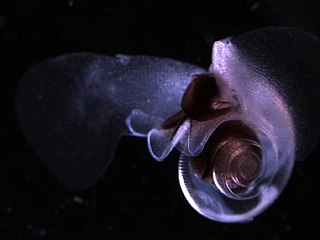
Limacina is a genus of swimming predatory sea snails commonly known as sea butterflies in the family Limacinidae. This genus contains some of the world's most abundant gastropod species.
Desmopteridae is a family of pelagic sea snails or "sea butterflies", marine gastropod mollusks in the superfamily Cymbulioidea.
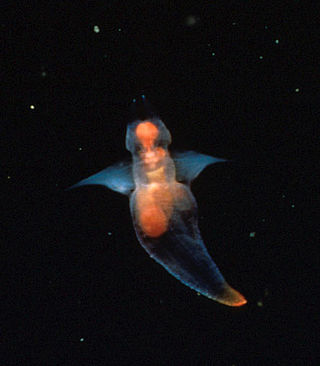
The Clionidae are a family of sea angels, which are a group of pelagic marine gastropods.

Glaucus atlanticus is a species of sea slug in the family Glaucidae.

Glaucus marginatus is a species of small, floating, blue sea slug; a pelagic (open-ocean) aeolid nudibranch; a marine opisthobranch gastropod mollusc in the family Glaucidae. This species is closely related to Glaucus atlanticus, and is part of a species complex along with Glaucus bennettae, Glaucus thompsoni, and Glaucus mcfarlanei. Like Glaucus atlanticus, it is commonly known as a blue dragon.

Atlanta is a genus of pelagic marine gastropod molluscs in the family Atlantidae. They are sometimes called heteropods.

Carinaria is a genus of medium-sized floating sea snails, pelagic gastropod molluscs in the family Carinariidae.

The Phylliroidae are a family of nudibranch sea snails, highly adapted to a pelagic lifestyle and occurring in tropical surface waters around the globe. The two species of the genus Phylliroe and Cephalopyge trematoides that have been assigned to this family are small to average in size, slender and highly transparent. They swim by undulating their whole body. Their foot is very small, which helps to reduce drag. They are carnivores that prey on planktonic jelly fish.
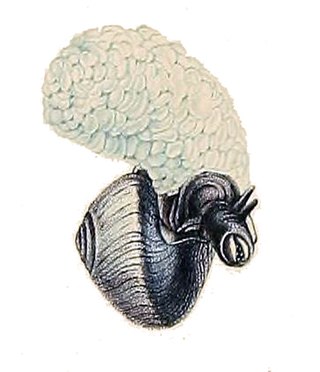
Janthina janthina is a species of holoplanktonic sea snail, a marine gastropod mollusk in the family Epitoniidae. Its common names include violet sea-snail, common violet snail, large violet snail and purple storm snail.

The Pterotracheoidea is, according to the Taxonomy of the Gastropoda, a taxonomic superfamily of sea snails or sea slugs, marine gastropod molluscs in the clade Littorinimorpha. They are commonly called heteropods or sea elephants.
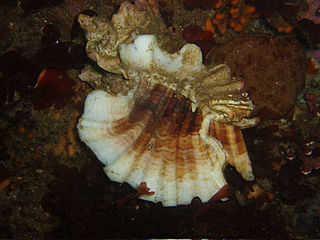
Ceratostoma, common name the "hornmouth" snails, is a genus of medium to large predatory sea snails, marine gastropod mollusks in the family Muricidae, the rock snails.

Glaucus is a genus of small blue pelagic sea slugs. They are aeolid nudibranchs, ranging in size from 20 to 40 mm. They feed on colonial cnidarians such as Portuguese man o' wars, blue buttons, and purple sails. They can produce painful and potentially dangerous stings when handled, as they store the venomous nematocysts of their prey. Glaucus is the only genus in the family Glaucidae. It includes five species.

Janthina exigua, also known as the dwarf janthina, is a species of small holoplanktonic sea snail, a marine gastropod mollusk in the family Epitoniidae, the violet snails or purple storm snails.
Atlanta oligogyra is a species of sea snail, a holoplanktonic marine gastropod mollusk in the family Atlantidae.

Atlanta peronii is a species of sea snail, a holoplanktonic marine gastropod mollusk in the family Atlantidae, as well as its typetaxon.

Carinaria cristata, commonly known as the glassy nautilus, is a species of pelagic marine gastropod mollusc in the family Carinariidae. It is found in the Pacific Ocean and is described as being holoplanktonic, because it spends its entire life as part of the plankton. It was first described by Carl Linnaeus in 1767. Its fragile shell was much prized by early conchologists for their collections, being so rare that it was said to be worth more than its weight in gold.
Carinaria galea, common name the helmeted carinaria, is a species of sea snail, a marine pelagic marine gastropod mollusc in the family Carinariidae. It was first described in 1835 by William Henry Benson, an amateur malacologist in the Bengal Civil Service.

Oppomorus is a genus of sea snails, marine gastropod mollusks in the family Muricidae, the murex snails or rock snails.















